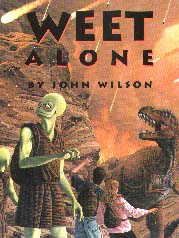|
________________
CM . . . .
Volume VI Number 13 . . . . March 3, 2000
excerpt: Eric shivered, closed his eyes, and drifted into sleep. That night his dreams were troubled by images of fiery collisions and horrible destruction. He awoke bleary-eyed and just as tired as he had been when he had gone to sleep.Weet Alone brings closure to the Weet trilogy which is set largely in the Cretacious period. Siblings Eric and Rose, plus their dog, Sally, have already twice time-travelled from contemporary Alberta and British Columbia to the same areas as they appeared some 65 million years ago. There, among all the dinosaurs, including predatory velociraptors and the fierce tyrannosaurus rex, the children met and befriended the title character, Weet, a humanoid dinosaur, who, in the opening novel, Weet, learned human speech. Since the adventures of the second book, Weet's Quest, a year has passed in Weet's life, but only 10 days elapse in the children's lives before a skiing accident propels the trio once more into Weet's time. Because Eric is an ardent dinosaur enthusiast, he is cognizant of prevailing scientific theories regarding the causes of the dinosaurs' extinction. When Eric observes increased meteor activities and the appearance of some 20 comets, one apparently headed toward Earth, he reluctantly shares with Weet the information that Weet's world will likely be destroyed by a collision between Earth and a large object from space. Weet, deciding he must warn his people about what is to happen, leaves the coastal peoples he encountered in Weet's Quest and, joined by his new mate, Saar, and the children, he journeys eastward. However, before the group reaches Weet's home, the catastrophic event occurs. Wilson's writing is at its best as he describes the impact and the various effects of the collision, including the blast, a fire storm and an earthquake. Equally powerful is Wilson's description of the aftermath as the survivors attempt to rebuild their lives in a forever altered world. While readers reluctantly recognize that Weet and his people are doomed, Wilson leaves Weet with optimism. Because Wilson does make reference to antecedent action in the book's opening sections, Weet Alone can stand "alone" as a separate read; however, young readers will find their reading experience greatly enhanced if they have previously encountered the earlier novels. Janice Armstrong's dramatic cover illustration will attract readers, and her eight full-page black and white illustrations, which are distributed throughout the book, add to the story. Wilson's two- page closing "Author's Note" provides the factual information which responds to the question he poses: "Did the dinosaurs really die out in the unimaginable flash of an intergalactic collision?" Highly Recommended. Dave Jenkinson teaches courses in children's and YA literature in the Faculty of Education, University of Manitoba.
To comment on this title or this review, send mail to cm@umanitoba.ca.
Copyright © the Manitoba Library Association.
Reproduction for personal use is permitted only if this copyright notice
is maintained. Any other reproduction is prohibited without
permission.
Published by
TABLE OF CONTENTS FOR THIS ISSUE - March 3, 2000.
AUTHORS |
TITLES |
MEDIA REVIEWS |
PROFILES |
BACK ISSUES |
SEARCH |
CMARCHIVE |
HOME
|
